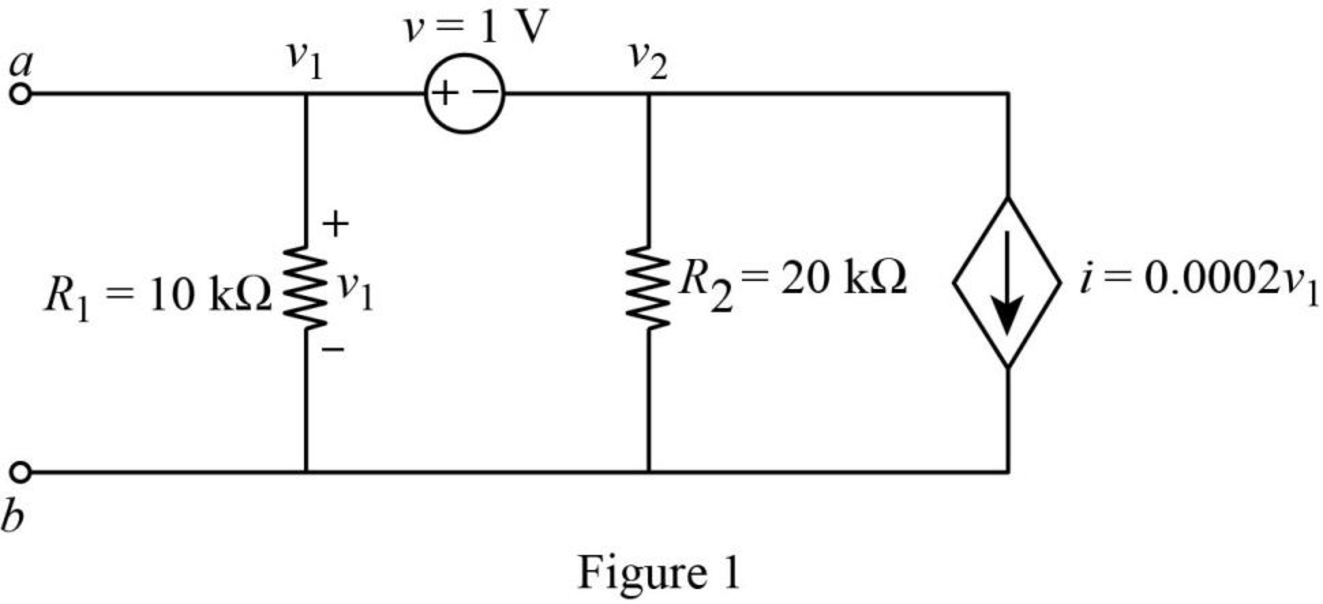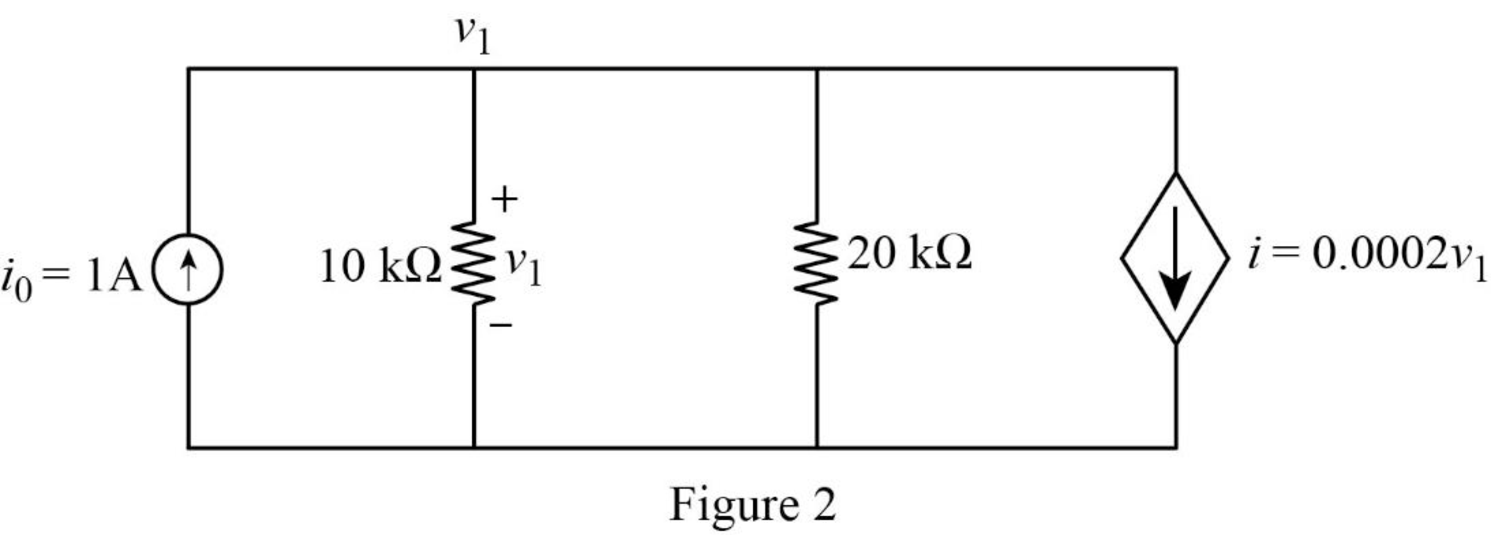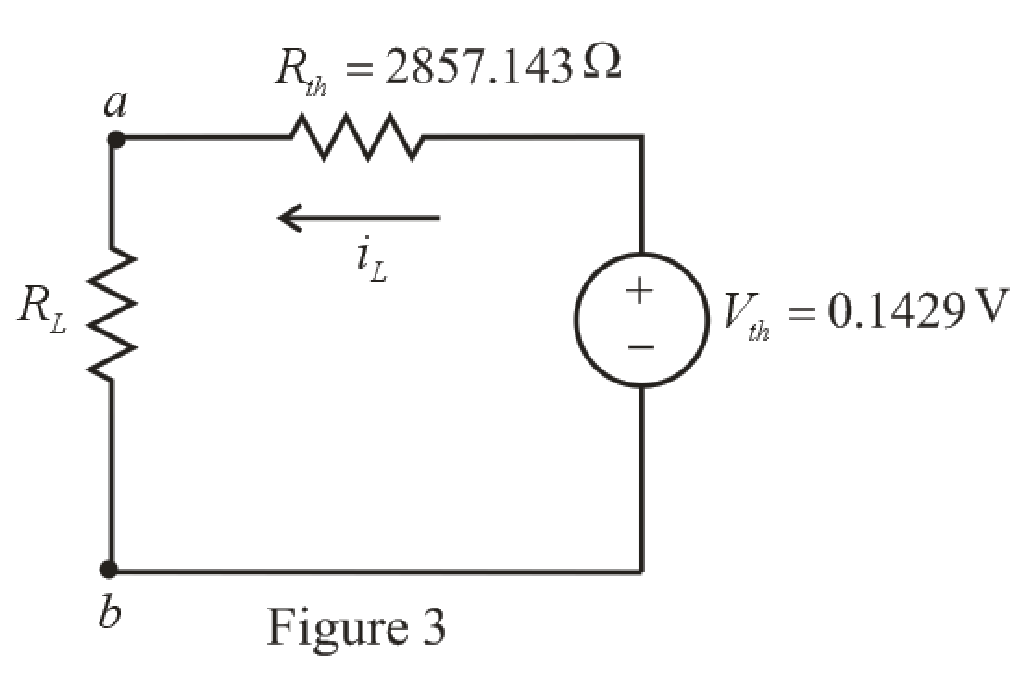
Concept explainers
(a)
Find the power dissipated by
(a)
Answer to Problem 41E
The power dissipated by
Explanation of Solution
Given Data:
The load resistance is
Formula used:
The expression for the power dissipated by load resistor is as follows.
Here,
Calculation:
The redrawn circuit diagram is given in Figure 1,

Refer to the redrawn Figure 1,
Apply Kirchhoff’s current law at node 1.
Here,
Substitute
Rearrange for
Rearrange for
Apply Kirchhoff’s voltage law between node 1 and 2.
Substitute
Rearrange for
So, the Thevenin voltage is
The redrawn circuit diagram is given in Figure 2,

Refer to the redrawn Figure 2.
Apply Kirchhoff’s current law at node 1.
Here,
Substitute
Rearrange for
The expression for the Thevenin equivalent resistance is as follows,
Here,
Substitute
The redrawn circuit diagram is given in Figure 3,

Refer to the redrawn Figure 3,
The expression for the current flowing in the circuit is as follows.
Here,
Substitute
Substitute
Conclusion:
Thus, the power dissipated by
(b)
The power dissipated by
(b)
Answer to Problem 41E
The power dissipated by
Explanation of Solution
Given Data:
The load resistance is
Calculation:
Refer to the redrawn Figure 3,
Substitute
Substitute
Conclusion:
Thus, the power dissipated by
(c)
The power dissipated by
(c)
Answer to Problem 41E
The power dissipated by
Explanation of Solution
Given Data:
The load resistance is
Calculation:
Refer to the redrawn Figure 3,
Substitute
Substitute
Conclusion:
Thus, the power dissipated by
Want to see more full solutions like this?
Chapter 5 Solutions
ENGINEERING CIRCUIT...(LL)>CUSTOM PKG.<
- The normalized far-zone field pattern of an antenna is given by (sin cos²) E = 0 00 and 0 ≤ ≤ π/2. 3/22 π elsewhere Find the directivity using (a) the exact expression In the sent soalation Use Prad=2+1 7/2 Pre= 2 + 1 Sco³odo + 5 siño de Where did the 2 Com from?arrow_forwardPen and paper solution please with explaination not using chatgptarrow_forwardhowarrow_forward
- A four pole generator having wave wound armature winding has 51 slots ,each slot containing 20 conductors,what will be the voltage generated in the machine when driven at 1500rpm assuming the flux per pole is 7mWb Don't use Artificial intelligencearrow_forwardNeed Handwritten solution Do not use chatgpt Or AIarrow_forwardI need a detailed solution to a problem. The far-zone electric field intensity (array factor) of an end-fire two-element array antenna, placed along the z-axis and radiating into free-space, is given by E=cos (cos - 1) Find the directivity using (a) Kraus' approximate formula (b) the DIRECTIVITY computer program at the end of this chapter Repeat Problem 2.19 when E = cos -jkr 0505π $[ (cos + 1) (a). Elmax = Cost (case-1)] | max" = 1 at 8-0°. 0.707 Emax = 0.707.(1) = cos [(cose,-1)] (cose-1) = ± 0,= {Cos' (2) = does not exist (105(0)= 90° = rad. Bir Do≈ 4T ar=2() = = Bar 4-1-273 = 1.049 dB T₂ a. Elmax = cos((cose +1)), 0.707 = cos (Close,+1)) = 1 at 6 = π Imax (Cose+1)=== G₁ = cos(-2) does not exist. Girar=2()=π. 4T \cos (0) + 90° + rad Do≈ = +=1.273=1.049dB IT 2arrow_forward
- I need an expert mathematical solution. The E-field pattern of an antenna. independent of , varies as follows: 0° ≤ 0≤ 45° E = 0 45° {1 90° 90° < 0 ≤ 180° (a) What is the directivity of this antenna? (b) What is the radiation resistance of the antenna at 200 m from it if the field is equal to 10 V/m (rms) for Ø = 0° at that distance and the terminal current is 5 A (rms)?arrow_forwardI need an expert mathematical solution. The normalized far-zone field pattern of an antenna is given by E = {® (sin cos)/ 0 Find the directivity using 0 ≤ 0 ≤ π and 0≤ 0≤ π/2. 3m2sds2, elsewherearrow_forwardI need an expert mathematical solution. The radiation intensity of an aperture antenna, mounted on an infinite ground plane with perpendicular to the aperture. is rotationally symmetric (not a function of 4), and it is given by sin (7 sin 0) U π sin Find the approximate directivity (dimensionless and in dB) usingarrow_forward
- Waveforms v1(t) and v2(t) are given by:v1(t) = −4 sin(6π ×10^4t +30◦) V,v2(t) = 2cos(6π ×10^4t −30◦) V.Does v2(t) lead or lag v1(t), and by what phase angle?arrow_forward7.1 Express the current waveform i(t) = -0.2 cos(6 × 10°1 +60°) mA in standard cosine form and then determine the following: (a) Its amplitude, frequency, and phase angle. (b) i(t) at t=0.1 ns.arrow_forward3. Consider the RC circuit with a constant voltage source shown in the diagram below. The values of the resistor, capacitor, and input voltage are R = 50, C = 10 µF, and V = 6V, respectively. Assume that there is initially no charge on the capacitor before the switch is closed. Vo ↑i(t) R w C When the switch closes at time t = 0, the current begins to flow as a function of time according to the equation i(t) = ioencarrow_forward
 Introductory Circuit Analysis (13th Edition)Electrical EngineeringISBN:9780133923605Author:Robert L. BoylestadPublisher:PEARSON
Introductory Circuit Analysis (13th Edition)Electrical EngineeringISBN:9780133923605Author:Robert L. BoylestadPublisher:PEARSON Delmar's Standard Textbook Of ElectricityElectrical EngineeringISBN:9781337900348Author:Stephen L. HermanPublisher:Cengage Learning
Delmar's Standard Textbook Of ElectricityElectrical EngineeringISBN:9781337900348Author:Stephen L. HermanPublisher:Cengage Learning Programmable Logic ControllersElectrical EngineeringISBN:9780073373843Author:Frank D. PetruzellaPublisher:McGraw-Hill Education
Programmable Logic ControllersElectrical EngineeringISBN:9780073373843Author:Frank D. PetruzellaPublisher:McGraw-Hill Education Fundamentals of Electric CircuitsElectrical EngineeringISBN:9780078028229Author:Charles K Alexander, Matthew SadikuPublisher:McGraw-Hill Education
Fundamentals of Electric CircuitsElectrical EngineeringISBN:9780078028229Author:Charles K Alexander, Matthew SadikuPublisher:McGraw-Hill Education Electric Circuits. (11th Edition)Electrical EngineeringISBN:9780134746968Author:James W. Nilsson, Susan RiedelPublisher:PEARSON
Electric Circuits. (11th Edition)Electrical EngineeringISBN:9780134746968Author:James W. Nilsson, Susan RiedelPublisher:PEARSON Engineering ElectromagneticsElectrical EngineeringISBN:9780078028151Author:Hayt, William H. (william Hart), Jr, BUCK, John A.Publisher:Mcgraw-hill Education,
Engineering ElectromagneticsElectrical EngineeringISBN:9780078028151Author:Hayt, William H. (william Hart), Jr, BUCK, John A.Publisher:Mcgraw-hill Education,





